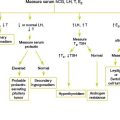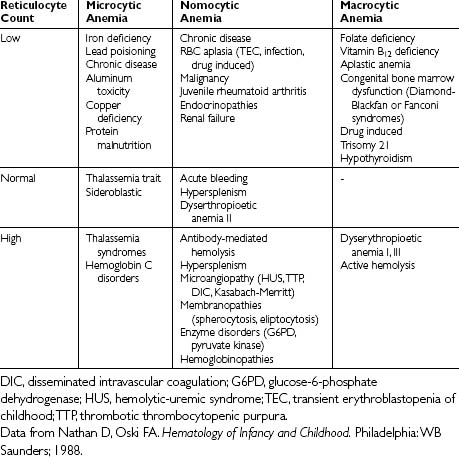Chapter 40 SPEECH AND LANGUAGE PROBLEMS
General Discussion
A basic knowledge of speech milestones is necessary to determine whether a child has speech delay. These speech milestones are presented in Table 40-1. Children’s speech and language can be evaluated at any age when there is a suspicion of delay or disorder. The most common referral is to a speech-language pathologist for an evaluation. If the speech-language service does not have audiology services, a referral should be made to an audiologist or an otologist for a hearing evaluation.
| Age | Achievement |
|---|---|
| 1-6 mo | Coos in response to voice |
| 6-9 mo | Babbling |
| 10-11 mo | Imitation of sounds; says “mama/dada” without meaning |
| 12 mo | Says “mama/dada” with meaning; often imitates two- and three-syllable words |
| 13-15 mo | Vocabulary of four to seven words in addition to jargon; <20% of speech understood by strangers |
| 16-18 mo | Vocabulary of 10 words; some echolalia and extensive jargon; 20% to 25% of speech understood by strangers |
| 19-21 mo | Vocabulary of 20 words; 50% of speech understood by strangers |
| 22-24 mo | Vocabulary >50 words; two-word phrases; dropping out of jargon; 60% to 70% of speech understood by strangers |
| 2 to 2 1/2 yr | Vocabulary of 400 words, including names; two- to three-word phrases; use of pronouns; diminishing echolalia; 75% of speech understood by strangers |
| 2 1/2-3 yr | Use of plurals and past tense; knows age and sex; counts three objects correctly; three to five words per sentence; 80% to 90% of speech understood by strangers |
| 3-4 yr | Three to six words per sentence; asks questions, converses, relates experiences, tells stories; almost all speech understood by strangers |
| 4-5 yr | Six to eight words per sentence; names four colors; counts 10 pennies correctly |
Information from Schwartz ER. Speech and language disorders. In: Schwartz MW, ed. Pediatric Primary Care: A Problem Oriented Approach. St. Louis: Mosby; 1990:696–700.)
Causes of Speech Problems
Causes of Language Problems
Key Historical Features
 Caregiver, family, or teacher concern about not meeting perceived milestones
Caregiver, family, or teacher concern about not meeting perceived milestones
 Detailed history of developmental milestones at specific ages
Detailed history of developmental milestones at specific ages
 Number of languages spoken to the child
Number of languages spoken to the child
 Aptitude of verbal versus nonverbal communication
Aptitude of verbal versus nonverbal communication
 Level of intelligence in other areas
Level of intelligence in other areas
 Language development milestones
Language development milestones
 Ability of child to communicate with close family members versus strangers or medical team
Ability of child to communicate with close family members versus strangers or medical team
Key Examination Findings
 Plotting of weight, height, and head circumference over time
Plotting of weight, height, and head circumference over time
 Vision and hearing evaluations
Vision and hearing evaluations
 General evaluation of well-being
General evaluation of well-being
 Evaluation of appropriate eye contact
Evaluation of appropriate eye contact
 Craniofacial examination for anatomic or syndromic abnormalities
Craniofacial examination for anatomic or syndromic abnormalities
 Head and neck examination for:
Head and neck examination for:
 Thorough neurologic examination
Thorough neurologic examination
Suggested Work-Up
| Early Language Milestone Scale | Used to assess language development in children younger than 3 years. Focuses on expressive, receptive, and visual language. Relies primarily on the parents’ report |
| Peabody Picture Vocabulary Test Revised | Used for children 2.5 to 18 years of age to screen for word comprehension. If the child is bilingual, performance on the test should be compared with that of other bilingual children of similar cultural and linguistic backgrounds |
| Denver Developmental Screening Test | Comprehensive developmental assessment to evaluate for a global intellectual impairment, which may manifest initially as a delay in speech development |
| Audiometry | Indicated for all children with speech delay |
| Tympanometry | To evaluate eardrum compliance |
| Complete blood count (CBC) and general chemistry panel | May be considered to screen for anemia or metabolic disorders |
Additional Work-Up
| Test of intelligence | For children whose results on the Denver Developmental Screening Test indicate an abnormal condition |
| Auditory brainstem response | Useful in infants and uncooperative children to evaluate for peripheral hearing loss |
| Karyotype for chromosomal abnormalities and a DNA test | For children who have the phenotypic appearance of fragile X syndrome |
| Electroencephalogram (EEG) | Should be considered for children with seizures or with significant receptive language disabilities |
| Thyroid-stimulating hormone (TSH) | If hypothyroidism is suspected |
| Referral to a pediatric neurologist | If a neurologic disorder is suspected |
| Referral to a developmental pediatrician | If a developmental delay is suspected or discovered on the Denver Developmental Screening Test |
1. Coplan J. Quantifying language development from birth to 3 years using the Early Language Milestone Scale. Pediatrics. 1990;86(6):963–971.
2. Cunningham M., Cox E.O. Hearing assessment in infants and children: recommendations beyond neonatal screening. Pediatrics. 2003;111(2):436–440.
3. Denckla M.B. Language disorders. In: Downey J.A., Low N.L., editors. The Child with Disabling Illness:Principles of Rehabilitation. New York: Raven; 1982:175–202.
4. Feldman M.H. Evaluation and management of language and speech disorders in preschool children. Pediatr Rev. 2005;26:131–141.
5. Leung A.K.C., Kao C.P. Evaluation and management of the child with speech delay. Am Fam Physician. 1999;59:3121–3127.
6. Schum R.L. Language screening in the pediatric office setting. Pediatr Clin North Am. 2007;54(3):425–436.
7. Schwartz E.R. Speech and language disorders. In: Schwartz M.W., editor. Pediatric Primary Care: A Problem Oriented Approach. St. Louis: Mosby; 1990:696–700.
8. Shonkoff J.P. Language delay: late talking to communication disorder. In: Rudolph A.M., Hoffman J.I., Rudolph C.D., editors. Rudolph’s Pediatrics. London: Prentice-Hall; 1996:124–128.
9. U.S. Preventive Services Task Force. Screening for speech and language delay in preschool children: recommendation statement. Pediatrics. 2006;117:497–501.
10. Yoon G., et al. Speech and language delay are early manifestations of juvenile-onset Huntington disease. Neurology. 2006;67:1265–1267.











